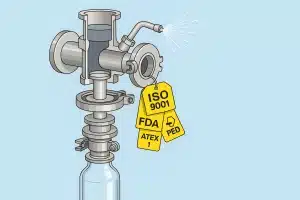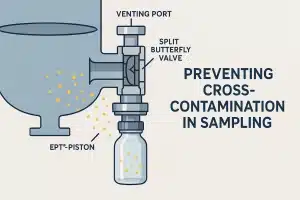Selecting the right sampling valve for your industrial fluid systems is crucial for maintaining process efficiency, safety, and accuracy. The proper valve can make a significant difference in the quality of your samples and the overall performance of your system. This comprehensive guide will walk you through the essential factors to consider when choosing a sampling valve, helping you make an informed decision for your specific application.
What factors should I consider when selecting a sampling valve?
When it comes to selecting the right valve for your industrial fluid systems, several crucial factors come into play. The process of valve selection requires a thorough understanding of your specific application and the conditions under which the valve will operate. By carefully considering these factors, you can ensure that you choose the correct valve that will perform optimally in your system.
How does the process fluid affect valve selection?
The type of process fluid flowing through your industrial fluid systems is a primary consideration when selecting the right valve. Different fluids have varying properties that can impact valve performance and longevity. For instance, corrosive fluids may require valves made from special materials to resist degradation, while viscous fluids might necessitate valves with specific designs to ensure proper flow control. Understanding the chemical composition, viscosity, and other characteristics of your process fluid is essential in making the right choice for your sampling valve.
What role does temperature and pressure play in choosing a sampling valve?
Temperature and pressure are critical factors in valve selection, particularly for sampling valves in industrial fluid systems. High temperatures can affect the material integrity of valve bodies and seals, potentially leading to leaks or failures. Similarly, pressure conditions within the valve can impact its performance and lifespan. When choosing the right valve, it’s crucial to consider both the operating and maximum temperature and pressure ratings of your process. This ensures that the valve you select can withstand the specific conditions of your application, maintaining safety and efficiency in your sampling process.
Why is flow rate important in sampling valve selection?
Flow rate plays a significant role in selecting the appropriate valve for your sampling needs. The right valve should be able to control the flow of your process fluid effectively, ensuring accurate and representative samples. If the flow rate is too high, it may lead to turbulence within the valve, affecting sample quality. Conversely, if it’s too low, you might not obtain sufficient sample volume. Understanding the required flow rate for your specific application helps in choosing a valve with the correct size and design to maintain optimal performance and sampling accuracy.
What are the different types of sampling valves available?
There are various types of valves used in industrial fluid systems for sampling purposes. Each valve type has its unique characteristics, advantages, and limitations. Understanding the different valve types and their applications is crucial in selecting the right valve for your specific needs. Let’s explore some of the most common types of sampling valves and their performance in various applications.
How do ball valves perform in sampling applications?
Ball valves are widely used in industrial fluid systems due to their versatility and reliability. In sampling applications, ball valves offer several advantages. They provide excellent shutoff capabilities, making them ideal for controlling the flow of process fluids during sampling. Ball valves are also known for their durability and ability to handle high pressures and temperatures.
Their quarter-turn operation allows for quick opening and closing, which can be beneficial in time-sensitive sampling processes. However, it’s important to note that standard ball valves may not be suitable for all sampling applications, particularly those requiring precise flow control or dealing with highly viscous fluids.
When are butterfly valves suitable for sampling?
Butterfly valves can be an excellent choice for certain sampling applications in industrial fluid systems. These valves are known for their compact design and ability to handle large flow rates with minimal pressure drop. Butterfly valves are particularly suitable for sampling applications that require quick shutoff and where space is limited. They perform well in low-pressure systems and can be cost-effective for larger pipe sizes.
However, butterfly valves may not be the best choice for applications requiring fine flow control or dealing with highly viscous fluids. When considering butterfly valves for sampling, it’s crucial to evaluate the specific requirements of your process and ensure that the valve construction and materials are compatible with your process fluid.
What are the advantages of needle valves for sampling?
Needle valves offer unique advantages in sampling applications, particularly when precise flow control is required. These valves feature a long, tapered plug that allows for very fine adjustments to the flow rate. This makes needle valves ideal for applications where accurate, repeatable sampling is crucial. They are often used in high-pressure systems and can handle a wide range of temperatures. Needle valves are also excellent for gas sampling due to their ability to provide controlled, low-flow rates. However, they may not be suitable for applications requiring high flow rates or those dealing with particulate-laden fluids that could clog the narrow passageways within the valve.
How do I determine the right size for my sampling valve?
Determining the correct size for your sampling valve is a critical step in ensuring optimal performance of your industrial fluid systems. Valve sizing impacts various aspects of your sampling process, including flow rate, pressure drop, and overall system efficiency. To choose the right valve size, you need to consider several factors related to your specific application and process conditions.
What is the relationship between valve size and flow rate?
The relationship between valve size and flow rate is fundamental in selecting the right valve for your sampling needs. Generally, larger valves allow for higher flow rates, while smaller valves restrict flow. However, it’s not always a matter of choosing the largest valve possible. The correct valve size should provide the desired flow rate while maintaining control over the sampling process.
Oversized valves may lead to poor control and excessive turbulence, while undersized valves can cause excessive pressure drop and inadequate sample volume. To determine the right size, you need to calculate the required flow rate for your sampling process and select a valve that can handle this flow while operating within its optimal range.
How does valve sizing affect pressure drop?
Valve sizing has a significant impact on pressure drop within your sampling system. Pressure drop refers to the decrease in fluid pressure as it flows through the valve. An appropriately sized valve will minimize pressure drop while still providing adequate control over the sampling process.
If a valve is too small for the required flow rate, it can create excessive pressure drop, potentially leading to cavitation, noise, and reduced valve life. On the other hand, an oversized valve may not provide sufficient back pressure, resulting in poor control and potentially inaccurate samples. When selecting the right valve size, it’s crucial to calculate the expected pressure drop and ensure it falls within acceptable limits for your specific application.
Can undersized or oversized valves impact sampling accuracy?
Yes, both undersized and oversized valves can significantly impact sampling accuracy in industrial fluid systems. An undersized valve may not allow sufficient flow for representative sampling, potentially leading to biased results. It can also create excessive turbulence within the valve, affecting the sample’s integrity. Conversely, an oversized valve might not provide adequate control over the sampling process, potentially resulting in inconsistent sample volumes or difficulties in obtaining small, precise samples.
To ensure accurate sampling, it’s crucial to choose the right valve size that balances flow requirements with control capabilities. This often involves working closely with valve manufacturers or consulting with experts to make the right choice based on your specific application and process conditions.
Which valve materials are best for corrosive processes?
When dealing with corrosive processes in industrial fluid systems, material selection for sampling valves becomes paramount. The right valve material can significantly extend the life of your valve, ensure reliable operation, and maintain the integrity of your samples. Let’s explore some of the best valve materials for corrosive environments and how to select them based on your specific application.
What are the most corrosion-resistant valve materials?
Several materials are known for their excellent corrosion resistance and are commonly used in valve construction for corrosive processes. Stainless steel, particularly grades like 316 and 317, offers good resistance to many corrosive chemicals and is widely used in industrial applications. For more severe corrosive environments, materials like Hastelloy, Monel, or titanium may be necessary.
These alloys provide superior corrosion resistance but come at a higher cost. Fluoropolymers like PTFE (Teflon) are also excellent choices for highly corrosive applications, offering both chemical resistance and low friction. When selecting the right valve material, it’s crucial to consider not only the corrosiveness of your process fluid but also factors like temperature, pressure, and mechanical stress that the valve will experience.
How do I select valve materials for high-temperature applications?
Selecting valve materials for high-temperature applications in corrosive environments requires careful consideration. The combination of high temperature and corrosive fluids can accelerate material degradation, making material selection even more critical. For these challenging conditions, specialized alloys like Inconel or Hastelloy are often the materials of choice. These materials maintain their strength and corrosion resistance at elevated temperatures.
Ceramic materials, such as silicon carbide or alumina, can also be excellent options for extreme temperature and corrosive applications. When choosing the right valve material for high-temperature corrosive processes, it’s essential to consider not only the valve body but also the seals and other components. Ensure that all parts of the valve can withstand both the temperature and the corrosive nature of your process fluid.
Are there cost-effective options for mildly corrosive environments?
While highly corrosion-resistant materials offer excellent protection, they can be expensive. For mildly corrosive environments, there are more cost-effective options that can still provide adequate protection. Certain grades of stainless steel, such as 304 or 316, can be suitable for many mildly corrosive applications at a lower cost than more exotic alloys. Plastic materials like PVC or CPVC can also be cost-effective choices for low-temperature, mildly corrosive environments.
Some manufacturers offer valves with corrosion-resistant coatings or linings, which can provide a balance between cost and performance. When selecting a cost-effective option, it’s crucial to carefully evaluate your process conditions and consult with valve manufacturers to ensure the chosen material will provide adequate protection and longevity for your specific application.
How does valve construction impact sampling effectiveness?
The construction of a sampling valve plays a crucial role in its effectiveness and reliability in industrial fluid systems. Various aspects of valve construction, including the design of internal components, sealing mechanisms, and actuation methods, can significantly impact sampling accuracy and ease of use. Understanding these factors is essential in selecting the right valve for your specific application.
What are the benefits of single-use versus reusable sampling valves?
The choice between single-use and reusable sampling valves depends on your specific application and requirements. Single-use sampling valves offer several advantages in certain situations. They eliminate the need for cleaning and sterilization between uses, reducing the risk of cross-contamination. This can be particularly beneficial in pharmaceutical or food processing industries where product purity is critical.
Single-use valves also save time and resources that would otherwise be spent on cleaning and maintenance. However, they generate more waste and can be more expensive in the long run. Reusable sampling valves, on the other hand, are more cost-effective for frequent sampling and generate less waste. They can be designed for easy cleaning and sterilization, making them suitable for many industrial applications. The choice between single-use and reusable valves should be based on factors such as sampling frequency, cleanliness requirements, and overall operational costs.
How do different seat designs affect sampling accuracy?
The seat design of a sampling valve can significantly impact sampling accuracy in industrial fluid systems. Different seat designs offer varying levels of sealing capability, flow characteristics, and resistance to wear. For instance, a metal-to-metal seat design may provide excellent durability in high-temperature applications but might not offer the tight sealing required for accurate sampling of gases or volatile liquids. Soft-seated valves, using materials like PTFE or elastomers, can provide better sealing but may have temperature limitations. Some advanced seat designs incorporate features to minimize dead space or ensure complete flushing of the sampling area, which can be crucial for maintaining sample purity. When selecting the right valve, consider how the seat design will interact with your process fluid and affect the accuracy and repeatability of your sampling process.
What role does the actuator play in sampling valve performance?
The actuator is a critical component in sampling valve performance, particularly in automated or remote sampling applications. The type and quality of the actuator can affect the speed, precision, and reliability of the sampling process. Pneumatic actuators are commonly used in industrial settings due to their simplicity and reliability. They can provide quick opening and closing times, which can be crucial for time-sensitive sampling.
Electric actuators offer precise control and are often used in applications requiring specific positioning or modulating control. Some advanced actuators incorporate features like position feedback or fail-safe operation, enhancing the overall safety and reliability of the sampling system. When choosing a sampling valve, consider not only the valve itself but also the actuator type and its compatibility with your control systems and sampling requirements.
What are the key considerations for low-pressure sampling applications?
Low-pressure sampling applications present unique challenges in industrial fluid systems. These systems require careful consideration of valve selection and system design to ensure accurate and reliable sampling. Understanding the specific requirements and potential issues associated with low-pressure sampling is crucial for choosing the right valve and implementing effective sampling strategies.
How can I minimize pressure loss in low-pressure systems?
Minimizing pressure loss is critical in low-pressure sampling applications to maintain system efficiency and ensure accurate samples. To achieve this, several strategies can be employed. First, selecting the right valve type and size is crucial. Valves with a full-bore design, such as ball valves or gate valves, typically offer lower pressure drop compared to reduced-bore designs.
Proper valve sizing is also essential; an oversized valve can lead to poor control, while an undersized valve can cause excessive pressure drop. Additionally, considering the overall system design, including pipe sizing and configuration, can help minimize pressure losses. Using smooth-bore tubing or piping and minimizing the number of fittings and bends in the sampling line can significantly reduce pressure loss. In some cases, implementing a bypass or recirculation loop can help maintain adequate pressure for sampling in low-pressure systems.
Which valve types are most suitable for low-pressure sampling?
Several valve types can be suitable for low-pressure sampling applications, each with its own advantages. Ball valves are often a good choice due to their full-bore design and low pressure drop characteristics. They also provide excellent shutoff capabilities and are available in a wide range of materials to suit various process fluids. Diaphragm valves can be another excellent option for low-pressure sampling, particularly in applications requiring high purity or where contamination is a concern. These valves offer good flow characteristics and minimal dead space, reducing the risk of sample contamination.
For applications requiring precise flow control, needle valves or fine-metering valves might be more appropriate, although care must be taken to size them correctly to avoid excessive pressure drop. When selecting the right valve for low-pressure sampling, consider not only the pressure characteristics but also factors like material compatibility, ease of cleaning, and specific sampling requirements of your application.
What precautions should I take when sampling from low-pressure processes?
When sampling from low-pressure processes, several precautions should be taken to ensure accurate and safe sampling. First, it’s crucial to avoid creating excessive pressure drop in the sampling system, which could disrupt the process or lead to inaccurate samples. This may involve using larger diameter sampling lines or implementing a bypass system to maintain adequate flow. Second, consider the potential for contamination or sample degradation.
In low-pressure systems, there’s a risk of ambient air being drawn into the sample, particularly if the sampling point is not properly purged. Implementing proper purging procedures and using closed sampling systems can help mitigate this risk. Additionally, be aware of the potential for phase changes in your process fluid at low pressures, which could affect sample representativeness. In some cases, special sampling techniques or equipment may be necessary to maintain sample integrity. Finally, ensure that all sampling equipment, including valves, tubing, and collection vessels, are appropriate for low-pressure applications and compatible with your process fluid. By taking these precautions, you can ensure reliable and accurate sampling from low-pressure processes in your industrial fluid systems.
Conclusion:
Selecting the right sampling valve is far more than a simple purchasing decision—it’s a critical process that directly impacts the performance, safety, and accuracy of your industrial fluid systems. The journey to finding the perfect valve requires a comprehensive understanding of multiple factors, including process fluid characteristics, temperature and pressure conditions, flow rates, material compatibility, and specific application requirements.





